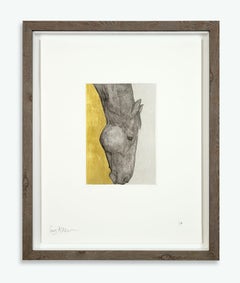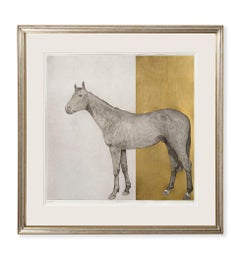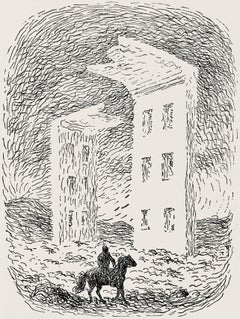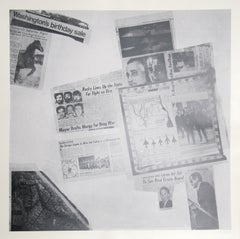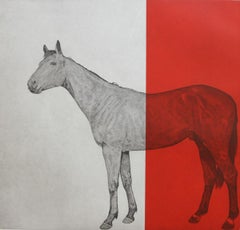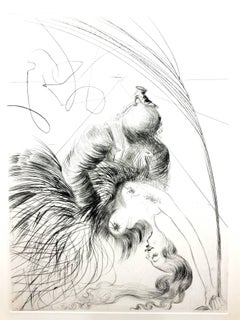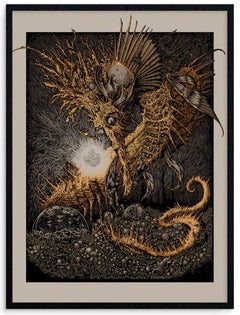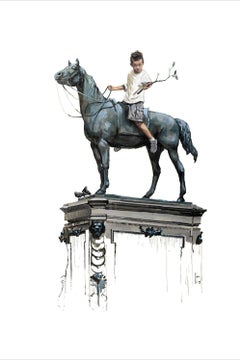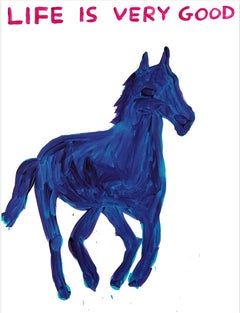Horse Still-life Prints
to
1
2
1
1
1
Overall Width
to
Overall Height
to
2
1
3
1
2
3
1
1
2
2
1
3,836
849
786
698
496
426
384
273
261
232
195
191
187
155
152
139
138
136
125
111
3
2
2
2
2
3
2
Art Subject: Horse
Guy Allen, Grazing Horse Study Gold, Limited Edition Contemporary Horse Art
By Guy Allen
Located in Deddington, GB
Guy Allen
Grazing Horse Study Gold
An etching, aquatint and hand finished gold leaf on 300gsm Somerset paper.
Edition Size: 75
Year Completed: 2017
Image Size: H 19.5cm x W 13.5cm
Paper Size: 56 x 39 cm
Sold Unframed
(Please note that in situ images are purely an indication of how a piece may look)Please note the price is for the unframed original etching .
Grazing Horse Study Gold is an original etching, engraved onto a copper plate, from which Guy Allen creates an impression of ink onto paper. To create his pieces, Guy Allen marries the traditional technique of etching with timeless subject matter and print making processes, for a more contemporary twist.
This etching is a study piece for the large Grazing Horse artwork...
Category
21st Century and Contemporary Contemporary Animal Prints
Materials
Gold
Guy Allen, Equine Gold, Affordable Contemporary Art
By Guy Allen
Located in Deddington, GB
Guy Allen
Equine Gold
Etching, Aquatint and Hand Finished Gold Leaf
Edition Size: 75
Year Completed: 2019
Image Size: H 60cm x W 60cm
Approximate Size When Framed: H80cm xW 80cm
Sold...
Category
21st Century and Contemporary Contemporary Animal Prints
Materials
Gold Leaf
Magritte, Composition, Les chants de Maldoror (after)
Located in Auburn Hills, MI
Lithograph on vélin papier pur chiffon paper. Paper Size: 10 x 7.375 inches. Inscription: Unsigned and unnumbered, as issued. Notes: From the album, Les chants de Maldoror, illustrat...
Category
1940s Surrealist Figurative Prints
Materials
Lithograph
$956 Sale Price
20% Off
Features from Currents, #57, Pop Art Screenprint by Robert Rauschenberg
Located in Long Island City, NY
Artist: Robert Rauschenberg
Title: Features from Currents, #57
Year: 1970
Medium: Hand-Printed Silkscreen on Aqua B 844 Paper, signed and numbered in pencil
Edition: 50
Paper S...
Category
1970s Conceptual Still-life Prints
Materials
Screen
Hosre Study Red, Guy Allen, Bright Art, Red Art, Animal Art, ModernEquine Prints
By Guy Allen
Located in Deddington, GB
Guy Allen
Horse Study Red
Limited Edition Screen Print
Edition of 45
Sheet Size: H 77cm x 80cm x D 0.2cm
Sold Unframed
Horse Study Red’s medium: Etching, aquatint and screen print c...
Category
21st Century and Contemporary Animal Prints
Materials
Canvas, Screen
Related Items
Salvador Dali - The Woman of the Shoe - Original Stamp-Signed Etching
Located in Collonge Bellerive, Geneve, CH
Salvador Dali - The Woman of the Shoe - Original Stamp-Signed Etching
Stamp signed by Dali
Edition of 294 copies.
Paper : Arches vellum.
Dimensions : 16x12".
Catalogue Raisonné : ...
Category
1960s Surrealist Figurative Prints
Materials
Etching
$1,787
H 16 in W 12 in D 0.1 in
The Celestial Hippocampus (Ed. 88/140)
Located in Dallas, TX
"The Scar by China Miéville is a novel which has been a part of my life for many years, and has travelled as my companion through since adolescence. I've attempted to depict the Avan...
Category
21st Century and Contemporary Surrealist Animal Prints
Materials
Screen
Salvador Dali - The Torso - Original Stamp-Signed Etching
Located in Collonge Bellerive, Geneve, CH
Salvador Dali - The Torso - Original Stamp-Signed Etching
Stamp signed by Dali
Edition of 294 copies.
Paper : Arches vellum.
Dimensions : 16x12".
Catalogue Raisonné : Field 68-6 (...
Category
1960s Surrealist Figurative Prints
Materials
Etching
$1,787
H 16 in W 12 in D 0.1 in
Salvador Dali - Woman on Horse - Original Stamp-Signed Etching
Located in Collonge Bellerive, Geneve, CH
Salvador Dali - Woman on Horse - Original Stamp-Signed Etching
Stamp signed by Dali
Edition of 294 copies.
Paper : Arches vellum.
Dimensions : 16x12"....
Category
1960s Surrealist Figurative Prints
Materials
Etching
$1,787
H 16 in W 12 in D 0.1 in
Lobster, Pop Art Screenprint by Hunt Slonem
By Hunt Slonem
Located in Long Island City, NY
Artist: Hunt Slonem
Title: Lobster
Year: 1980
Medium: Screenprint, signed and numbered in pencil
Edition: 250; AP 30
Image: 19 x 19 inches
Paper Size: 22 x 30 inches
Category
1980s Contemporary Still-life Prints
Materials
Screen
Salvador Dali - The Violet Boot - Original Stamp-Signed Etching
Located in Collonge Bellerive, Geneve, CH
Salvador Dali - The Violet Boot - Original Stamp-Signed Etching
Stamp signed by Dali
Edition of 294 copies.
Paper : Arches vellum.
Dimensions : 16x12".
Catalogue Raisonné : Field ...
Category
1960s Surrealist Figurative Prints
Materials
Etching
$1,787
H 16 in W 12 in D 0.1 in
Cats (Pink)
By Ai Weiwei
Located in London, GB
Screen print on Saunders Waterford 300gsm paper
Hand-signed, dated, and numbered by the artist
45 x 62 cm
Edition 78 of 300
The print was editioned by master printer, Kip Gresham at The Print Studio, Cambridge for Kettle's Yard. It was made using an original drawing ‘cut’ into an acrylic sheet. The image is then reversed when printed.
Description from the publisher:
"Drawing has been fundamental to Ai Weiwei’s artistic practice from an early age. He also has a longstanding love of cats, and they appear frequently in the artist’s social media posts. Many cats used to roam his studio in Beijing. As part of the Kettle’s Yard exhibition, Ai’s ‘Cats wallpaper...
Category
2010s Contemporary Animal Prints
Materials
Screen
"C de Cabra" contemporary engraving surrealist goat
Located in Ciudad de México, MX
The repetition of patterns and rhythm is present in almost every piece of Pedro´s work.
The hybrid topographies that Pedro Friedeberg´s unclassifiable practice recreates we must rec...
Category
21st Century and Contemporary Surrealist Figurative Prints
Materials
Engraving
$1,445
H 16.15 in W 11.82 in
Bird On Flower, Aquatint Etching by Keiko Minami
By Keiko Minami
Located in Long Island City, NY
Artist: Keiko Minami, Japanese (1911 - 2004)
Title: Bird On Flower
Year: circa 1985
Medium: Aquatint Etching, Signed and numbered in pencil
Edition: 12...
Category
1980s Folk Art Animal Prints
Materials
Etching, Aquatint
Regal Chief, Surrealist Still Life Screenprint by Michael Knigin
Located in Long Island City, NY
Regal Chief
Michael Knigin, American (1942–2011)
Date: 1979
Screenprint, signed, numbered, dated, and titled in pencil
Edition of AP
Image Size: 18 x 25.5 inches
Size: 21.5 x 29.5 in...
Category
1990s Pop Art Still-life Prints
Materials
Screen
$650
H 21.5 in W 29.5 in
Salvador Dali - Venus in Furs - Original Stamp-Signed Etching
Located in Collonge Bellerive, Geneve, CH
Salvador Dali - Original Etching
Stamp signed by Dali
Edition of 294 copies.
Paper : Arches vellum.
Dimensions : 16x12".
Catalogue Raisonné : Field 68-6 (p. 40-41).
Salvador Dal...
Category
1960s Surrealist Figurative Prints
Materials
Etching
$1,787
H 16 in W 12 in D 0.1 in
Managua #1, Pop Art Screenprint by Hunt Slonem
By Hunt Slonem
Located in Long Island City, NY
Artist: Hunt Slonem, American (1951 - )
Title: Managua #1
Year: 1980
Medium: Screenprint, signed and numbered in pencil
Edition: AP 30
Image Size: 22 x 25 inches
Size: 26 in. ...
Category
1970s Contemporary Animal Prints
Materials
Screen
Previously Available Items
Fresh Start (Ed. 33/250)
Located in Dallas, TX
Unsigned
Archival Pigment Print on Hahnemuhle 210gsm 50% rag watercolor paper
13″x19″ paper size
Hand-numbered edition of 250
Embossed with the Heliotrope Foundation logo
Ernest...
Category
21st Century and Contemporary Surrealist Still-life Prints
Materials
Rag Paper, Archival Pigment
David Shrigley 'Life Is Very Good' print
Located in San Rafael, CA
David Shrigley (English b. 1968)
Life is Very Good, 2016
Off-set lithograph
Open edition, unframed
60 x 80 cm (23.62 x 31.5 inches)
Printed on 200g Munken Ly...
Category
21st Century and Contemporary Contemporary Still-life Prints
Materials
Offset
